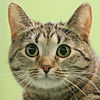British shorthair
The British Shorthair (abbreviated: BKH, English British Shorthair ) is a pedigree cat . The breed has been known since the late 19th century and has been purposefully bred for over 100 years.
General
The Romans probably brought the first cats with them to Great Britain . For centuries, British domestic cats were largely isolated on the islands. It was not until the middle of the 19th century that the British Shorthair began to be bred specifically for color and type on this basis. In 1871, the first cats were in England breed British Shorthair in Crystal Palace issued. When the breeding population declined sharply in the period after the world wars, some breeders tried to strengthen the breed again by outcrossing with other breeds. After attempts had failed to use unregistered domestic cats for crossbreeding, the choice fell on Persian cats . Above all, it was hoped that this cross would improve the type of British Shorthair. Further crossings took place with the Carthusian cat , whose breeding stock had also suffered from the wars. Due to an approximation of the two breeds, the British Shorthair and the Chartreux or Chartreux were combined by the FIFe breed association in 1970 . All blue cats were then listed as Carthusian , all cats of other colors as British Shorthair . This classification was withdrawn in 1977 after protests by breeders of the original Carthusian monks.
The blue British Shorthair is popularly - but wrongly and misleadingly - still called Carthusian and in some breeding clubs under this name. But today you can no longer confuse the blue British Shorthair with the real Carthusian cat, the Chartreux, as it differs significantly from the real Carthusian cat through targeted breeding, especially in physique. The crossbred Persian cats cause the British Shorthair to be massive, short and stocky, while the figure of the real Carthusian cats is more like a natural domestic cat .
In the 1980s, the European Shorthair split from the British Shorthair, which had previously also been shown in a class with the British Shorthair. In the USA, the British Shorthair was not recognized by the CFA breeders' association until 1980 .
Character and appearance
The British Shorthair cat is rather calm and not too lively , especially in comparison with Orientals . It has a short and dense fur that is crisp to the touch. It is characterized by a lot of undercoat, so that it pops up easily. Because Persians were bred after the world wars because of the scarce breeding stock, long-haired British are now and then in the litter. On January 1st, 2002 the FIFe decided that only short-haired cats could be called British. As a result, the BKH with half-length hair were sidelined for a long time. In the meantime, this form of the BKH is recognized by most associations as British Longhair (BLH). (e.g. from the WCF since August 2008 and from the TICA from May 2009 ). They only have half-long hair (also with a thick undercoat like the BKH, but in contrast to the Persian cat, semi-long hair) and are also called Highlanders, Lowlanders or Britannica.
British Shorthair cats are muscular and powerfully built, their legs short and stocky, paws large and round, and tails slightly shorter than other breeds. Everything about her is round: the broad chest, the head, the broad, short ears and the large, expressive eyes. BKH cats develop rather slowly. The full size is only reached from two years. A normally developed tomcat weighs between 7 and 8 kg, cats between 4 and 6 kg.
In contrast to many other cat breeds, the typical BKH is usually not afraid of water.
The characteristic color of the eyes is orange or copper, mostly green in the silver varieties and blue in the points. To date, over 50 color variations of the British Shorthair are known. These can be divided into the categories full color, bicolor and point. There is also the well-known tabby drawing. The full colors include white, black, blue, chocolate, lilac, cinnamon, fawn, red, and cream. These colors are combined with white in the bicolor and point variants. The most popular and well-known color variations are: blue and silver tabby in Classic, Spotted and Mackerel.
Web links
- Character of the British Shorthair Cat Lots of information about the British Shorthair cat
- The history of the British Shorthair in cat content
- CFA Breed Article: British Shorthair (English)










